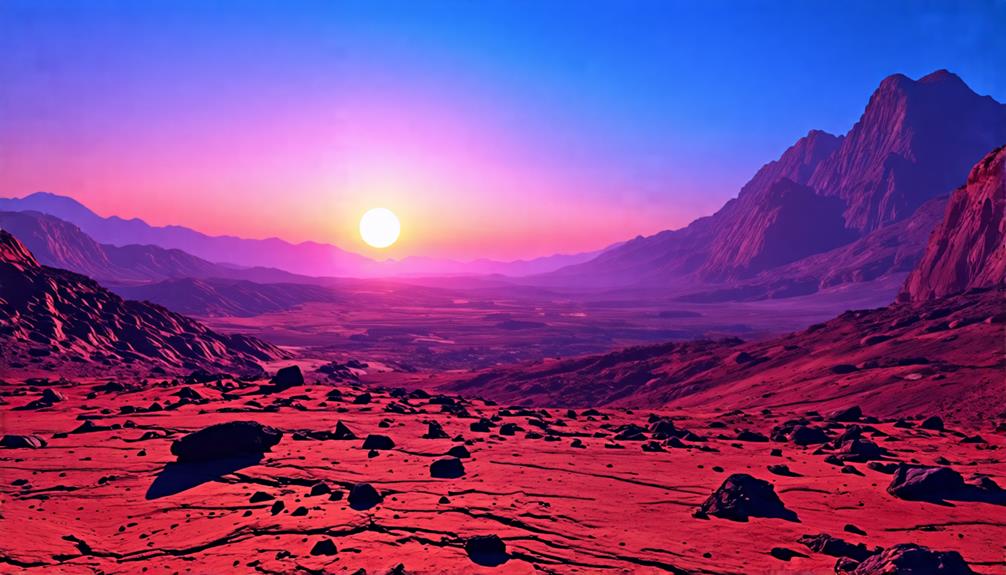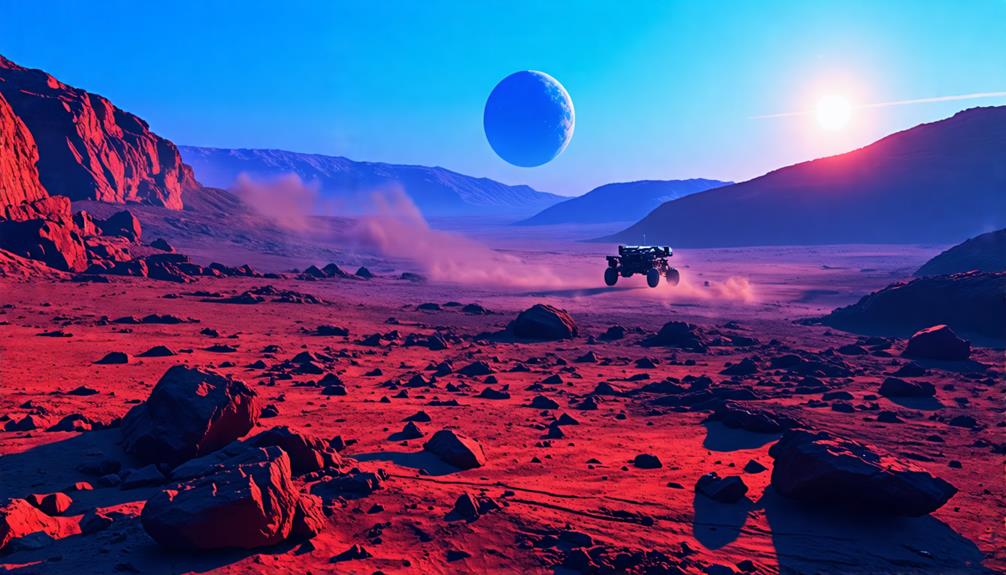You've likely marveled at the vibrant oranges and reds of Earth's sunsets, but on Mars, you'd witness a strikingly different scene. The Red Planet's sunsets are actually blue, a phenomenon that challenges our terrestrial expectations. This peculiar occurrence isn't just a cosmic oddity; it's a window into the complex interplay of light and atmosphere on our neighboring world. As you ponder this alien spectacle, you might wonder what other surprises Mars holds in store. The blue Martian sunset is just the beginning of a fascinating journey into the planet's unique characteristics and the potential it holds for future exploration.
Key Takeaways
- Mars' thin atmosphere, composed mostly of carbon dioxide, causes unique light scattering conditions.
- Blue wavelengths scatter more widely than red wavelengths in the Martian atmosphere.
- Fine dust particles suspended in Mars' atmosphere enhance the blue light scattering effect.
- NASA rovers have captured images confirming the blue hue of Martian sunsets.
Martian Atmospheric Composition

While Mars' atmosphere is drastically thinner than Earth's, it's primarily composed of carbon dioxide, which plays an essential role in shaping the planet's unique sunsets. The Martian atmosphere, containing 95.3% carbon dioxide, creates an environment where light behaves differently than on Earth.
You'll find that fine dust particles suspended in this thin atmosphere profoundly influence light scattering, leading to the distinctive blue sunset phenomenon.
As sunlight passes through the atmosphere, the iron-rich dust scatters red light, allowing shorter blue wavelengths to dominate. This process is enhanced by the low atmospheric pressure, which is less than 1% of Earth's.
Unlike Earth's moisture-rich atmosphere, Mars lacks water vapor and clouds, further contributing to its unique light scattering effects. The combination of these factors results in the mesmerizing blue hue you'd observe during sunsets on Mars.
Light Scattering on Mars
The intricacies of light scattering on Mars create a celestial spectacle unlike anything you'd witness on Earth.
On the Red Planet, you'll find that light behaves differently due to its thin atmosphere and unique composition. As sunlight travels through Mars' carbon dioxide-rich air, it encounters fine dust particles that greatly influence how it scatters.
During a Martian sunset, you'd notice that blue light scatters more widely than red, creating a striking blue hue near the sun. This phenomenon, confirmed by the Curiosity rover mission's science team, is a result of Rayleigh scattering.
The lack of water vapor and the presence of dust in Mars' atmosphere enhance this effect. While Earth's sunsets are known for their reddish tones, you'll be amazed by the otherworldly blue glow that dominates the Martian twilight sky.
Observational Evidence and Implications

Robotic explorers on Mars have captured stunning evidence of the planet's unique sunsets, confirming theories about its atmospheric composition and light-scattering properties. NASA's Mars rovers, including Curiosity and Perseverance, have consistently observed bluish hues during Martian sunsets. This phenomenon occurs because blue light scatters more easily through the thin atmosphere and Martian dust, while red light is absorbed.
The Curiosity Rover's images and spectroscopy studies have quantified the scattering of different wavelengths, supporting the theory that Martian dust enhances blue light visibility during dusk. These observations have implications for understanding Mars' climate dynamics and atmospheric conditions.
Here are three emotional aspects of witnessing a sunset on Mars:
- Awe at the alien beauty of a blue sunset
- Wonder at the vastness of space and our place in it
- Excitement for future human exploration of the Red Planet
Conclusion
You've now learned about Mars' unique blue sunsets, a result of its thin, CO2-rich atmosphere and fine dust particles.
As you imagine these alien skies, remember that Rayleigh scattering is key to this phenomenon.
NASA's rovers have captured these breathtaking views, offering you a glimpse into another world.
Next time you watch a sunset on Earth, you'll appreciate how different it'd be on the Red Planet, where blue dominates the fading light.

Leave a Reply